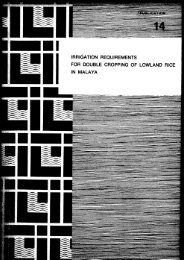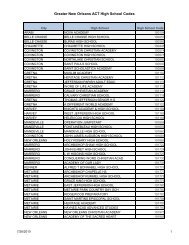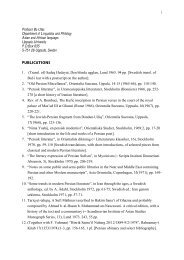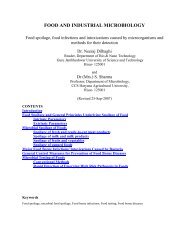On the Future of Indigenous Traditions - Munin
On the Future of Indigenous Traditions - Munin
On the Future of Indigenous Traditions - Munin
Create successful ePaper yourself
Turn your PDF publications into a flip-book with our unique Google optimized e-Paper software.
<strong>the</strong>y are <strong>the</strong> indigenous peoples including <strong>the</strong> definition given by Martinaz Cobo,<br />
which is <strong>the</strong> most accepted definition 7 at <strong>the</strong> United Nations level.<br />
Considering that <strong>the</strong> Adivasis or <strong>the</strong> tribal peoples in India are <strong>the</strong> indigenous peoples<br />
despite <strong>the</strong> statement made by <strong>the</strong> government <strong>of</strong> India, for <strong>the</strong> convenience <strong>of</strong> <strong>the</strong><br />
discussion <strong>the</strong> term Adivasi is used in this <strong>the</strong>sis. The term Adivasi is commonly used<br />
and also among <strong>the</strong> Adivasis <strong>the</strong>mselves or ei<strong>the</strong>r by <strong>the</strong>ir group’s name. In <strong>the</strong> non-<br />
Hindi speaking areas <strong>the</strong>y prefer to call <strong>the</strong>mselves tribe or tribal people instead <strong>of</strong><br />
Adivasis. However, <strong>the</strong> Adivasis or tribals are categorized and listed as ‘Scheduled<br />
Tribes’ or ‘Anusuchit Jan-Jati’ as per <strong>the</strong> Constitution <strong>of</strong> India. In addition to <strong>the</strong><br />
Adivasis being classified as Scheduled Tribes and <strong>the</strong>ir areas as Scheduled Areas and<br />
Tribal Areas, both <strong>the</strong>se areas have special constitutional provisions for <strong>the</strong>ir<br />
protection, managing <strong>the</strong>ir social affairs through <strong>the</strong>ir customary practices.<br />
1.1.2. The Status <strong>of</strong> <strong>the</strong> Adivasi in present day India<br />
Most, if not all, <strong>the</strong> Adivasi groups and <strong>the</strong>ir sub-groups in India are <strong>the</strong> first<br />
inhabitants in <strong>the</strong> regions <strong>the</strong>y live in today. The ‘traditional’ social organizations<br />
based on <strong>the</strong>ir customary systems / laws are mostly patrilineal, with a few exceptions<br />
<strong>of</strong> matrilineal systems.<br />
Adivasis are categorized in <strong>the</strong> constitution as “Scheduled Tribe” in English and its<br />
translation in Hindi, even in spite <strong>of</strong> strong protest by Jaipal Singh 8 to <strong>the</strong> President in<br />
<strong>the</strong> Constituent Assembly Debate, 9 to use <strong>the</strong> term Adivasi instead <strong>of</strong> “Ban Jati” (–<br />
meaning: <strong>the</strong> race that lives in <strong>the</strong> forest) <strong>the</strong>n, but later still translated as “Anusuchit<br />
Jana Jati” in Hindi. This is a category <strong>of</strong> people who can be identified as such, is<br />
done by <strong>the</strong> President <strong>of</strong> India in consultation with <strong>the</strong> Governor <strong>of</strong> <strong>the</strong> respective<br />
state or union territory (where <strong>the</strong>y reside). 10 It is done through public notification,<br />
7<br />
Benedict Kingsbury, “‘<strong>Indigenous</strong> Peoples’ in International Law: A Constructivist Approach to <strong>the</strong><br />
Asian Controversy,” in American Journal <strong>of</strong> International Law (n. p., 1998), 419.<br />
8<br />
Jaipal Singh was <strong>the</strong> first Adivasi, highly qualified, educated in <strong>the</strong> Oxford University, and <strong>the</strong><br />
founder <strong>of</strong> Jharkhand Party.<br />
9<br />
“Jaipal Singh’s speech in <strong>the</strong> Constituent Assembly Debate” Official Report, Vol. 9 (5 September<br />
1949), 994-995.<br />
10<br />
As given in <strong>the</strong> provision <strong>of</strong> Article 342 <strong>of</strong> <strong>the</strong> Constitution <strong>of</strong> India<br />
20

















